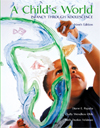 |
1 |  | 
emotions: feelings such as sadness, joy, and fear, which arise in response to situations and experiences and are expressed through altered behavior. |
 |
 |
2 |  | 
self- : Realization that one's existence is separate from other people and things. |
 |
 |
3 |  | 
: Person's characteristic disposition, or style of approaching and reacting to people and situations. |
 |
 |
4 |  | 
children: Children with a generally happy temperament, regular biological rhythms, and a readiness to accept new experiences. |
 |
 |
5 |  | 
children: Children with irritable temperament, irregular biological rhythms, and intense emotional responses. |
 |
 |
6 |  | 
- - - children: Children whose temperament is generally mild but who are hesitant about accepting new experiences. |
 |
 |
7 |  | 
goodness of fit: Appropriateness of environmental demands and constraints to a child's . |
 |
 |
8 |  | 
gender- : Socialization process by which children, at an early age, learn behavior deemed appropriate by the culture for a boy or girl. |
 |
 |
9 |  | 
versus : In Erikson's theory, the first crisis in psychosocial development, occurring between birth and about 18 months, in which infants develop a sense of the reliability of people and objects in their world. |
 |
 |
10 |  | 
attachment: Reciprocal, enduring relationship between and caregiver, each of whom contributes to the quality of the relationship. |
 |
 |
11 |  | 
Situation: Laboratory technique used to study attachment. |
 |
 |
12 |  | 
attachment: Attachment pattern in which an infant separates readily from the primary caregiver and actively seeks out the caregiver upon the caregiver's return. |
 |
 |
13 |  | 
attachment: Attachment pattern in which an infant rarely cries when separated from the primary caregiver and avoids contact upon his or her return. |
 |
 |
14 |  | 
(resistant) attachment: Attachment pattern in which an infant becomes anxious before the primary caregiver leaves, is extremely upset during his or her absence, and both seeks and resists contact on his or her return. |
 |
 |
15 |  | 
- attachment: Attachment pattern in which an infant, after being separated from the primary caregiver, shows contradictory behaviors upon his or her return. |
 |
 |
16 |  | 
Attachment Q-Set (AQS): Instrument for measuring attachment, developed by Waters and Deane, in which observer sorts descriptive words and phrases into those most and least characteristic of a child and compares these descriptors with descriptions of the "hypothetical most child." |
 |
 |
17 |  | 
Preschool Assessment of Attachment (PAA): Instrument for measuring attachment after 20 months of age, which takes into account the complexity of preschoolers' relationships and abilities. |
 |
 |
18 |  | 
Adult Attachment Interview (AAI): Instrument for measuring the clarity, coherence, and of an adult's memories of attachment to her or his parents. |
 |
 |
19 |  | 
: Process by which infant and caregiver communicate emotional states to each other and respond appropriately. |
 |
 |
20 |  | 
: Affective disorder in which a person feels unhappy and often has trouble eating, sleeping, and concentrating. |
 |
 |
21 |  | 
anxiety: Wariness of strange people and places, shown by some infants during the second half of the first year. |
 |
 |
22 |  | 
anxiety: Distress shown by an infant when a familiar caregiver leaves. |
 |
 |
23 |  | 
social : Understanding an ambiguous situation by seeking out another person's perception of it. |
 |
 |
24 |  | 
self-concept: Sense of self; descriptive and evaluative mental picture of one's abilities and . |
 |
 |
25 |  | 
versus : In Erikson's theory, the second crisis in psychosocial development, occurring between about 18 months and 3 years, in which children achieve a balance between self-determination and control by others. |
 |
 |
26 |  | 
: Behavior characteristic of toddlers, in which they express their desire for independence by resisting authority. |
 |
 |
27 |  | 
socialization: Process of developing the habits, skills, values, and motives shared by responsible, productive members of a particular . |
 |
 |
28 |  | 
: Process by which children accept societal standards of conduct as their own; fundamental to socialization. |
 |
 |
29 |  | 
self-regulation: Child's independent control of behavior to conform to understood social . |
 |
 |
30 |  | 
conscience: standards of behavior, which usually control one's conduct and produce emotional discomfort when violated. |
 |
 |
31 |  | 
compliance: In Kochanska's terminology, a toddler's wholehearted obedience of a parent's orders without reminders or lapses. |
 |
 |
32 |  | 
compliance: In Kochanska's terminology, a toddler's obedience of a parent's orders only in the presence of prompting or other signs of ongoing parental control. |
 |
 |
33 |  | 
reciprocity: In Maccoby's terminology, system of binding, responsive relationships into which a child is socialized. |
 |



 2002 McGraw-Hill Higher Education
2002 McGraw-Hill Higher Education